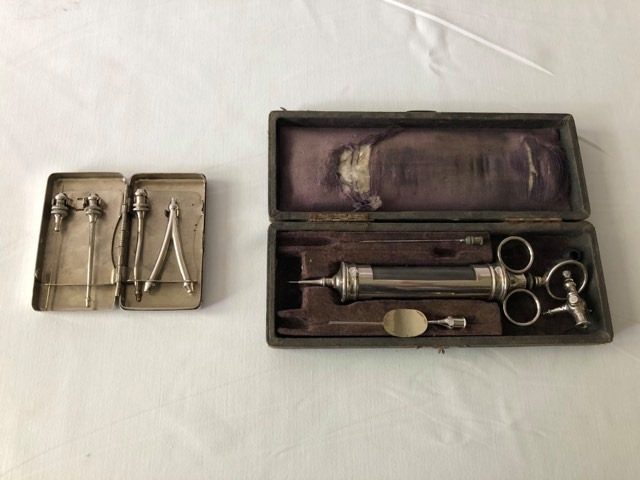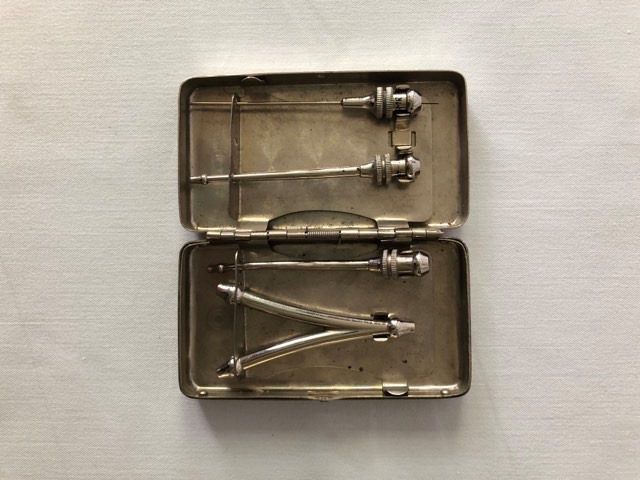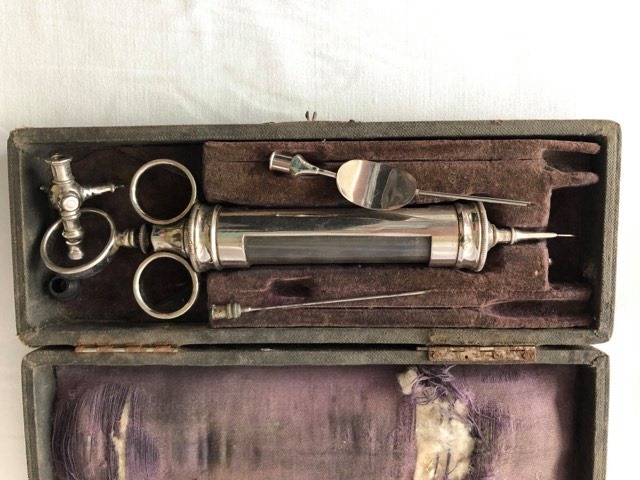Caution! This post includes historical medical information that may be nausea inducing for some readers.
These needles, syringes and medical devices are an interesting piece of medical history with no real equivalent in modern medical contexts. It is a miniature pocket case made of metal, which opens much like a lighter. The interior contains a number of holes in which to hold the components of a syringe buildable. This design was patented in 1893 by Davis and Co. The example pictured above was used by Dr. Menzies in the 1910’s-20’s, and was donated to us by his son in 1977.

Syringes were invented during the 1st century in Rome, described as a simple blunted plunger and chamber, capable of pulling in liquids. The first use of a syringe in a medical context was by Abu al-Qasim Ammar ibn Ali al-Mawsili from Mosul (modern day Iraq), who recorded the use of it in his book Kitāb al-muntakhab fī ilm al-ayn, which translates to “The book of choice in ophthalmology”. The syringes he created were used to remove cataracts from the eyes of a patient in order to restore sight, as he describes “Then I constructed the hollow needle, but I did not operate with it on anybody at all, before I came to Tiberias. There came a man for an operation who told me: Do as you like with me, only I cannot lie on my back. Then I operated on him with the hollow needle and extracted the cataract; and he saw immediately and did not need to lie, but slept as he liked. Only I bandaged his eye for seven days. With this needle nobody preceded me. I have done many operations with it in Egypt.”
This needle design involved no pointed end, and required the eye to be opened with a knife before employing the syringe. I it was much larger than modern syringes, requiring one hand to hold the device steady and the other to pull the plunger.
This model saw use until the 19th century, when medical syringe design faced the majority of its refinements. It was made to be smaller, have a hollow pointed needle, be capable of injection rather than reduction, and be operable by a single hand. The final version of the design was patented by Letitia Mumford Geer in 1899. At 13 years old she secured a patent for the her syringe design, which allowed operation by a single hand with the plunger being located close enough that the fingers of the same hand may press it. This design continued to be refined over time to be smaller, made of different parts for simple cleaning, changes to material, or other benefits of modern design.
These syringes were used as early as 1918. Roughly around that time immunologists and microbiologists made significant advances to medical science. During the early 18th century smallpox vaccinations were performed via a method called variolation. Varioulous material such as scabs, pus, or mucus, would be powdered and applied to shallow scratches on a healthy person’s skin. This method allowed for exposure to a controlled amount of a disease, providing the body to develop a natural immunity to smallpox with reduced risk to virulent infection.
The first injected vaccine was performed in 1796 by Edward Jenner. It was common knowledge at the time that women who milked cows were far less likely to contract smallpox. The cows they milked were often infected with cowpox, which would result in pus-filled blisters on the hands of the milkmaids. Edward Jenner scraped the pus from a woman who had been infected this way, and injected a sample of it into both arms of his gardener’s son James Phipps, who was 8 years old at the time of inoculation. James developed a fever and was somewhat sick, but eventually recovered fully. Edward then inoculated James with larger samples of smallpox pus. James didn’t get sick, and so he was injected with it again and still showed no sign of infection. Jenner concluded that the sampling of pus from infected people could be used to cure smallpox via injection, which was substantially safer than curing it through variolation. This practice became known as immunization via vaccine injection and was given freely by the British government in the 1840’s. Variolation was banned after this discovery.
Louis Pasteur proved in the 1860’s that bacteria is the cause of disease, not that disease is the cause of bacteria as was previously thought. He accidentally discovered that disease-causing bacteria could be isolated and weakened before being applied to an animal or person. He intended to test chicken cholera disease on a set of healthy chickens, but after a communication error between himself and his assistant his sample of cholera disease was left untouched and exposed to air for a month. Pasteur still used the weakened bacteria to infect his set of chickens and discovered that they would become mildly sick but recover and become healthy again. After being exposed and recovering this way, the chickens would not contract cholera disease even when exposed to a stronger amount of it. Pasteur then concluded that the bacteria which causes disease can be isolated and weakened to provide a reliable vaccine. He is credited with inventing the vaccine for rabies, swine erysipelas, anthrax, and chicken cholera.
The fleam (or Phleam) pictured below was used as a bloodletting knife, most likely in veterinary contexts, though bloodletting was a medical practice used for humans for hundreds of years. The fleam is designed specifically in a triangular pattern to be pushed into a vein and open it for blood to flow freely before being stopped. It was believed during the four humours era of medicine that blood was hot and someone suffering from a “hot” disease must be released of their excess blood. It did not help.
This blog was researched and written by Darren Ragoonath, Douglas College

